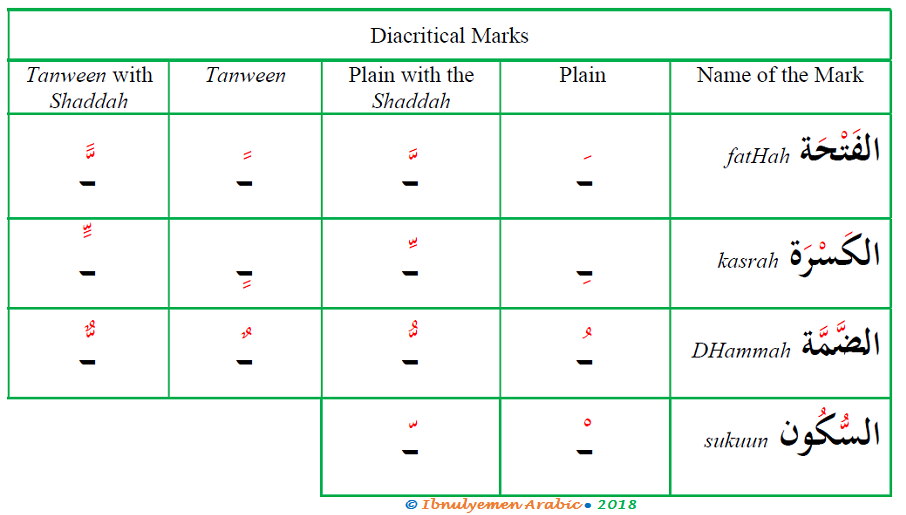In the Arabic Diacritics (1), you learned that Arabic diacritics are vocal letters. That is, we do not write them like the regular letters of the Arabic alphabet. Rather, they are marks or signs that we add above or below the letter. Textually, they you can see them in the Holy Quran, children's books, most school textbooks, and some books of poetry. We call these diacritical marks short vowels الْحَرَكَاتُ الْقَصِيرَة al-Harakaat al-qaSiirah. These marks are the fatha(fat-Ha, fathah) the kasra (kasrah), and the dhamma (dhammah). In addition, there are three other diacritical marks: sukuun, shadda, and tanween. In Arabic Diacritics (2), you will become familiar with how we add them to texts and how we pronounce them.

The above table includes all the diacritical marks in Arabic. The most basic of these are the three short vowels—the fatha, the kasra, and the dhamma. So, where do we place them in relation to the Arabic letters, and how do we pronounce them? We add the fatha over the letter, and its pronunciation is a. Similarly, we place the dhamma over the letter, and its pronunciation is u. On the other hand, we put the kasra below the letter, and its pronunciation is i. As for the sukuun, it simply means the absence of the three short vowels, and we add it over the letter. As an illustration, if we add these four diacritical marks over or below the letters (ت - س - ف - م), here is how we pronounce them:
|
تْ = t |
تُ = tu |
تِ = ti |
تَ = ta |
|
سْ = s |
سُ = su |
سِ = si |
سَ = sa |
|
فْ = f |
فُ = fu |
فِ = fi |
فَ = fa |
|
مْ = m |
مُ = mu |
مِ = mi |
مَ = ma |
With respect to the shadda, it means the doubling of a consonant letter. In other words, it is a sequence of two identical letters. The first has a sukuun over it, and the second has a short vowel over or below it. So, they get assimilated, and we write them as one letter with a shadda and a short vowel (i.e., َّ , ِّ , ُّ ). For instance, we pronounce the letters (ن - ل ) with a shadda in four different ways, as in these examples:
|
نْ + نْ ← نّ = nn |
نْ + نُ ← نُّ = nnu |
نْ + نِ ← نِّ = nni |
نْ + نَ ← نَّ = nna |
|
كَ نْ نْ ← كَنّ = kann |
سَ نْ نُ ← سَنُّ = sannu |
فَ نْ نِ ← فَنِّ = fanni |
مَ نْ نَ ← مَنَّ = manna |
|
لْ + لْ ← لّ = ll |
لْ + لُ ← لُّ = llu |
لْ + لِ ← لِّ = lli |
لْ + لَ ← لَّ = lla |
|
كُ لْ لْ ← كُلّ = kull |
سِ لْ لُ ← سِلُّ = sillu |
تَ لْ لِ ← تَلِّ = talli |
مَ لْ لَ ← مَلَّ = malla |
The tanween is double fatha on top of each other ( ً ), double kasra on top of each other ( ٍ ), or double dhamma ( ٌ ) next to each other. The pronunciation of double fatha (or tanween al fathah) is -an. However, we pronounce double kasra (or tanween al kasrah) -in. Unlike these, we pronounced double dhamma (or tanween al dhammah) -un. With regard to their position, we add them over or below the last letter of singular nouns and adjectives, as in the following examples (قَلَم 'pen' - كِتَابْ 'book' - بِنْتْ 'girl' - زَهْرَةْ 'flower'). With relation to its function and assignment, tanween has to with the grammar, which you will learn in future lessons. You can find more examples here.
|
قَلَمْ qalam |
قَلَمٌ qalam-un |
قَلَمٍ qalam-in |
قَلَمًا qalam-an |
|
كِتَابْ kitaab |
كِتَابٌ kitaab-un |
كِتَابٍ kitaab-in |
كِتَابًا kitaab-an |
|
بِنْتْ bint |
بِنْتٌ bint-un |
بِنْتٍ bint-in |
بِنْتًا bint-an |
|
زَهْرَةْ zahrah |
زَهْرَةٌ zahrat-un |
زَهْرَةٍ zahrat-in |
زَهْرَةً zahrat-an |
Similarly, the shadda with tanween occur only at the end of nouns and adjectives, namely over or below the last letter which is a doubled letter. The first letter has a sukuun and the second has a tanween, so they become a geminate (a doubled letter) with the tanween above or below it. For instance, each of these words ends in a geminate (حَقًّا 'a right, really' - رَفٌّ 'a shelf' - فَمٍّ 'a mouth' - جَدًّا 'a grandfather').
|
حَقّ Haqq |
حَقٌّ Haqq-un |
حَقٍّ Haqq-in |
حَقًّا Haqq-an |
|
رَفّ raff |
رَفٌّ raff-un |
رَفٍّ raff-in |
رَفًّا raff-an |
|
فَمّ famm |
فَمٌّ famm-un |
فَمٍّ famm-in |
فَمًّا famm-an |
|
جَدّ jadd |
جَدٌّ jadd-un |
جَدٍّ jadd-in |
جَدًّا jadd-an |
To find more example on Arabic Diacritics (2), you can explore our pins on Pinterest.
Thus, the fourteen diacritical marks in the table above are very important because they determine pronunciation, meaning, and grammar. In the next lesson, you will learn about their roles and functions.